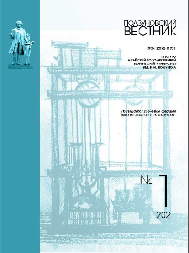STRUCTURE FORMATION FEATURES OF EPOXY RESIN DURING CURE PROCESS WITH AMINE HARDENER
doi: 10.25712/ASTU.2072-8921.2021.01.024
Keywords:
epoxy-diane resin, ED-22, polyethylene polyamine, PEPA, polymer material, thermal analysis, thermocouple, glass transition, gelation, exothermic reaction, structure formationAbstract
The kinetics of the condensation process of epoxy resins is different. This dependence is expressed in the stoichiometric cure of amine hardeners and epoxy resins. The analysis of thermal curves of epoxy-diane resin ED-22 with hardener PEPA of different concentrations without fillers was carried out in order to determine the time interval when using the resin as the base of the polymer coating for agricultural products. The method of thermal analysis in the study of the glass transition temperature range of the composition is based on recording changes in the heating and cooling temperatures of the composition over time. The analysis of the mechanisms of gelation and glass transition of the resin is carried out. During the analysis of the obtained curves, it was found that the glass transition process for ED-22 and PEPA, at any concentration of the hardener, consists of three stages. Each stage (stage) is characterized by its own rate of gelation, as well as the temperature at which this rate is maximum. The second stage of glass transition is the fastest, both in time and temperature range. The longest stage is the third, which is the final glass transition stage. On the basis of the obtained thermal curves, recommendations are given on the use of epoxy-diane resin in the technological process of production when applying coatings. It should be noted that the obtained thermal analysis data do not take into account the modification of the composition, as a result of that, it may be a shift of the thermal curves both to the region of higher temperatures and to the region of shortening / increasing the time interval for the reaction.
Downloads
Published
How to Cite
Issue
Section
License
Copyright (c) 2021 Snezhana A. Khaperskikh, Elena S. Anan’eva, Alesya A. Korkina

This work is licensed under a Creative Commons Attribution 4.0 International License.















 .
. This work is licensed under a
This work is licensed under a 
